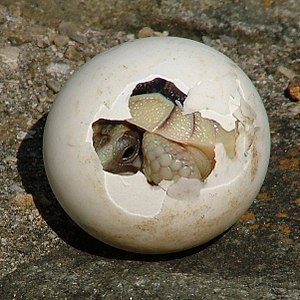Oviparity
Oviparous (Latin oviparus 'egg-born') refers to animals that lay eggs. The oviparity is opposed to the viviparity. The representatives of both forms of reproduction do not represent taxonomic groups (taxon), but are defined only by the characteristic.
True oviparity is a form of reproduction in which fertilized eggs are laid. In order for these to come into being, internal fertilisation is necessary by mating or by the ingestion of a spermatophore. The embryo is nourished throughout its embryogenesis (embryonic development) by the yolk stored in the egg. Once the young animal has reached a certain size and thus a certain stage of development after egg laying, it hatches.
Oviparous are the birds, most of the reptiles, including the dinosaur and other dinosaurs, and the greater part of the caudates, the arthropods, and the worms. The only oviparous mammals are the cloacanimals, which include the platypus and the four species of echidna.
The concept of oviparity is closely related to the taxon Amniota, whose characteristic is to be able to reproduce independently of water without a free larval stage.
Ovuliparity (from ovulation - as the emergence of unfertilized eggs) occurs when unfertilized eggs are laid, which are fertilized only outside the mother's body, that is, by external fertilization. Ovulipar are most bony fish and most of the frogs.
Oviparity is to be distinguished from viviparity. Animals in which the embryo grows in the womb and which do not usually "hatch" outside the mother's body are viviparous or viviparous. True viviparity exists only when the embryo is supplied by the mother's metabolism, often by a placenta. This is then referred to as placental viviparity.
A special form of oviparity or a transitional form between oviparity and viviparity is ovoviviparity. In this case, the egg remains in the womb. There the embryo is supplied by the yolk contained in the egg. The young animals can then hatch either already in the womb or shortly after egg laying. Ovoviviparous animals thus incubate their eggs inside the body. Often these are also somewhat inaccurately called viviparous. They include, for example, most sea snakes, many sharks and other cartilaginous fish, a few bony fish, some spiders, and the aphids.

Hatching turtle
Search within the encyclopedia